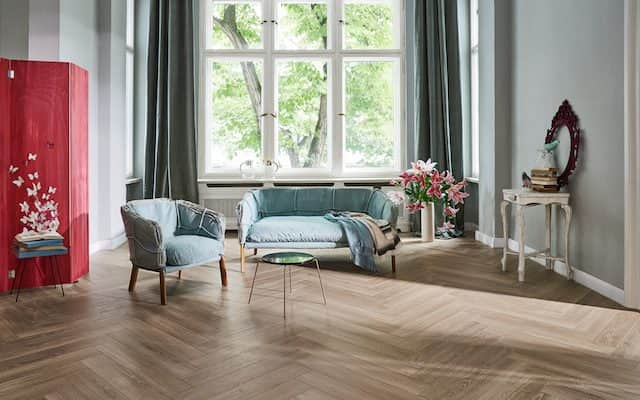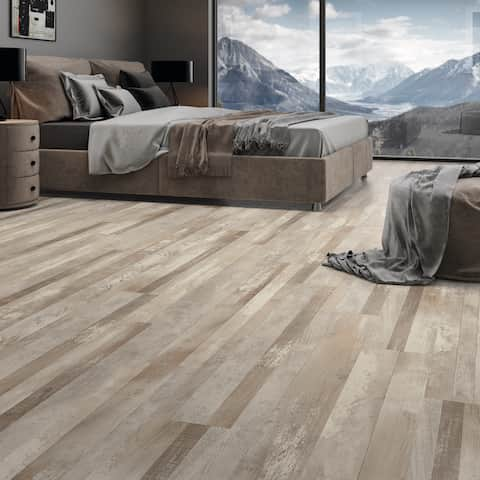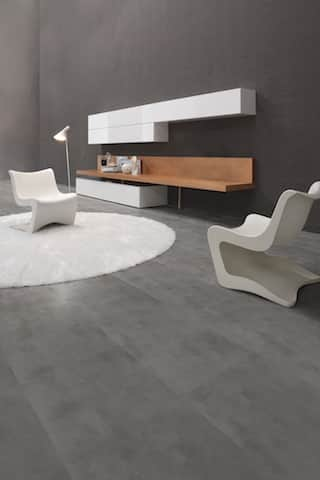
Laminate flooring manufacturers constantly scrutinise the current trends in fashion, architecture, interior design and daily life all over the world. Globalisation, urbanisation and digitalisation determine our lives. At the same time, these trends generate contradictory reactions: individualisation, a longing for nature, fusion, a touch of nostalgia – without appearing old-fashioned. One of the dominant megatrends is the longing for quiet and calming oases of retreat from our hectic world.
At home, people are looking for a relaxed, safe and easy life.
This is reflected in home furnishings. A gentle atmosphere, materials and surfaces that appeal to the senses with light, neutral colour palettes. This does not have to be perfect — style breaks are intentional and calculated. Subtle imperfections of nature or as a result of craftsmanship create an ambiance with a striving for authenticity.
Oak in change
These are the colours: neutral and soft shades, e.g. beige or greige, sometimes a restrained pink or rosé. Oak dominates in all nuances of nature, also with knots and an iridescent play of colours. Flaws, as we know them from the natural material, seem omnipresent in the reproduction of woods, but are softened by hinted patina or paints.
In oak floors, rounded structures meet modern colour tones. This is one of the reasons why oak remains the most important wood type, as it is versatile and can be combined very well with all kinds of interior design styles. As an alternative to the self-confident appearance of oak, subtle reproductions of chestnut are gaining popularity.
Minimalism and styles influenced by Buddhist zen are examples of current design trends. In addition, authentic impressions from Africa and South America with their warm, exotic earthy colours, handmade materials and natural elements are influencing designs. These are translated into warm, dark brown tones up to black.
Counterpoint to wood: concrete, granite, raw steel look
The new tile decors, concrete, granite and raw steel looks provide an interesting contrast to woods. In stone decors, grey tones are dominating, especially in the trendy concrete look. Matt and super-matt surface structures harmonise with this. All in all, surfaces become even deeper and more striking, differences from real wood are almost unnoticeable or invisible. In the technical implementation, the general aim is to further perfect the natural attributes of a real wood floor. The pore pattern and haptics of EIR (Embossed In Register) surface structures make the floor appear like natural wood.
Variety is also returning in terms of installation methods: the trend towards wider and longer planks, e.g. 200 x 20 cm, also 60 x 120 cm, 85 x 40 or 40 x 120 cm, continues. In addition, the plank is now more often 10 mm thick instead of 8 mm. Herringbone patterns are particularly popular.
Thanks to click connections on all sides, system planks allow quick and easy installation, as there is no need to distinguish between “right” and “left” planks. Each plank has a different shade of colour, which in combination, creates a harmonious, multi-faceted and particularly authentic colour play.
The market likes bevelled edges, which form a handcrafted V-joint after the planks have been joined together, as they offer aesthetic advantages over butt-jointed elements when exposed to grazing light. The latest designs of these bevels enable further opportunities for product differentiations, for example a four-sided “micro bevel”.
Reliable moisture protection – setting of for new shores
With several hours of water resistance, the new laminate floors can be used in rooms that were previously unavailable to them. The latest generation of laminate flooring can therefore also be used in bathrooms, kitchens or other functional rooms where moisture is generally to be expected.
For this purpose, the qualities of the carrier boards are modified, together with edge sealing or impregnation with hydrophobic oils and varnishes, to make laminate flooring water- resistant for up to 24 hours. Modified click systems prevent moisture from penetrating the joints and developing an undesirable life of its own in the subfloor.
In addition, the new water-resistant laminate floors are particularly robust and can therefore also be applied in heavily used rooms. By integrating underlay mats, some manufacturers offer floors that dampen the noise and can be laid directly on the prepared subfloor.
Laminate – a renewable natural product
Given the different sales channels and areas of application, laminate manufacturers want to score points with further improved product performance and new properties in competition with other materials. Laminate flooring with its wood-based materials stands for the careful and ecologically sustainable use of nature and wood as a renewable natural product. One supplier places particular emphasis on a sustainable business by only using wood from domestic cultivation, relying on low-emission production technologies and using waste wood in a biomass cogeneration plant to generate heat. The products of this manufacturer have now been certified with the “Blue Angel” eco-label. This fits perfectly in the current time, where the balance between economy and ecology is meeting an increased sensitivity. Consumers want sustainable products, but at the end of the day it’s the price that counts: this gives twice an advantage for laminate flooring.
